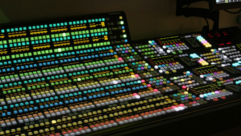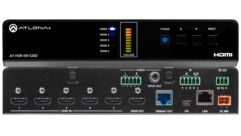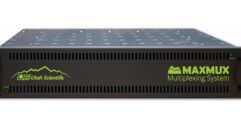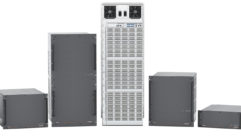
Matrix Switchers
Apr 29, 2014 10:35 AM,
By Christopher Maione
With the wide variety of signal types, both analog and digital, as well as the broad range of flatpanel and video projector displays and their respective resolutions, routing any given input to any given output or multiple outputs while preserving signal integrity can be a challenge. Matrix switchers, in configurations as simple as 2×2 or as complex as 64×64 and larger, have become essential in achieving fast and reliable signal delivery. Here’s a look at a gamut of matrix switchers for both large and small AV applications.

AMX Enova DVX-3155HD
AMX combines a controller, AV matrix switcher, signal converter, twisted-pair signal transmitter and amp, scaler, audio processor, and control unit in its Enova DVX-3155HD offering. Intended for conference room and auditorium applications needing teleconferencing solutions, the 3RU switcher can map 10 input signals out to up to four video outputs, and supports composite video up through HDMI. Other features include 14×4 matrix audio switching with independent audio signal control, video resolutions up to 1920×1200 @ 60Hz, and allows for manual setting or replication of EDIDs on any input. The unit is HDCP with control via hard keys and a front-facing LCD display. It features a programming port that supports RS-232 communication.

Analog Way SmartMatriX Ultra-SMX12x4
Analog Way’s SmartMatriX Ultra-SMX12x4 is a ruggedly designed switcher with 42 input jacks to serve its 12 inputs. Of the 42 jacks, there are six HDMI ports, nine DVI-I, three DisplayPort, 12 3G/HD/SDI, six 15-pin analog, and six DVI-A. The SMX can output 2560×1600 and 4096×2160 (4K) resolutions. Marketed for large-auditorium-based presentations, the SMX offers advanced screen layer management and can be used alone, or linked together with others, for showing images on differently configured hard and/or soft display surfaces. In addition to the four primary outputs, presentation monitoring has been allocated a dedicated preview output. There are preset views for an operator to have greater control over how shows are executed.

Atlona AT-PRO3HD44M
Atlona’s 4×4 AT-PRO3HD44M matrix switcher is capable of transmitting control, audio, and video signals over Ethernet. It features EDID learning for up to four displays and is HDCP compliant. Input ports include four HDMI for sources, five 3.5mm IR ports for use with a third-party controller, five 3.5mm IR outputs for passing IR codes to sources, four Ethernet ports to extend signals via Cat-5e/6/7 cables, an RS-232 for control with a PC or connection to a control processor, and a USB port for updating firmware. Audio distribution is simplified through use of the coaxial loop-out. It is compatible with Dolby TrueHD and DTS-HD audio formats. Compatible video resolutions include 1080p or 1920×1200. The front panel houses a LCD screen, IR receiver, and power, function, enter, cancel, and number buttons to choose input and output signal paths and change matrix settings.

Aurora Multimedia DXM-3232-G2
Aurora Multimedia’s DXM-3232-G2 is Aurora’s second-generation digital matrix switcher, featuring HDBaseT hot-swappable plug-in cards for 1080p signals to be transported up to 600ft. The 3232’s EDID learning and management feature make for simplified system setup. Display control is possible through passing of RS-232 signals. It is HDCP compliant. Connection types are card dependent, and include options for VGA, HDMI, Ethernet, DVI, and 3G/HD/SD/SDI. Status and operation can be managed via front-panel buttons and a backlit LCD display. Control may be managed over the main RS-232 port.

Blackbox Network Services AVSW-DVI
The AVSW-DVI by Black Box is a 4×1 DVI switcher suitable for applications where quick switching of both video and audio from various DVI sources to a single display is needed. Capable of routing video and audio from four sources to a display in full HD 1080p/1920×1200 resolutions, it is HDCP compliant and Blu-ray ready. It includes EDID copy function for optimal screen resolutions and provides full, transparent DDC support. Switching can be done using front-panel buttons, its IR remote controller, or through an RS-232 connection. The built-in serial interface enables control of the switcher via a PC, serial controller device, or a third-party control system.
Matrix Switchers
Apr 29, 2014 10:35 AM,
By Christopher Maione

Blackmagic Design Videohub
Blackmagic Design’s Videohub is a broadcast-quality video switcher with 72 inputs and 144 outputs. Capable of handling SD, HD, and 3Gbps SDI components, the Videohub automatically manages video patching through a software interface that easily changes video connections, re-clocks the SDI signal for long cable lengths, and allows multiple users to access any SDI video source all at the same time. Control is via the company’s Pushbutton View router control software that is designed to work on touchscreen monitors. Pushbutton Viewer features a library of icon buttons common to postproduction equipment and can handle multiple pages of sources and destinations.

Crestron DM-MD64x64
The DM-MD64x64 switcher is the second largest of the DM-MD family of Crestron switchers. It can handle 64 independent sources and distribute them to up to 64 different outputs. To support the size, the 64X64 uses up to 16 blade slots, eight for inputs and eight for outputs, which, along with redundant power supplies, can be swapped out on the fly. Depending on the blade configuration, acceptable input resolutions include everything from 640×480 @60Hz up to 4K 4096×2160 @24Hz. Blade configuration also dictates cabling requirements and media distribution distance; the maximum being 1,000ft. by using Crestron’s proprietary optical cable, CRESFIBER8G. Crestron’s DigitalMedia 8G+ is designed for compatibility with HDBaseT components with no digital media receiver required. At 14RU, the 64X64 is large enough to house a 15in. touchpanel display on its front side for configuration and setup. EDIDs are configurable such that all outputs display optimally.

DVIGear MXP Series
DVIGear’s MXP Series are non-blocking crosspoint digital matrix switchers that offer a range of cross-platform routing capabilities. The core of the MXP series is a high-speed digital routing engine that is available in multiple card frames, enabling I/O configurations from 9×9 up to 80×80. Using a modular architecture, the MXP series offers more than 60 I/O cards that use HDBaseT technology and support HDM/DVI signal extension over Cat-X cables up to 180 meters (590ft.); accommodates many different signal formats including single-link DVI, dual-link DVI, HDMI, DisplayPort, SD-SDI, HD-SDI, 3G-SDI, analog VGA, component video, etc.; and connection of several cable types directly to and from the router. The MXP series also features Advanced EDID Management and can be controlled by USB connection, RS-232/RS-422 serial port, TCP/IP Ethernet connection, and LAN using a built-in web interface.

Ensemble Designs Avenue Signal Integration System
Ensemble Designs’ Avenue Signal Integration System includes modules for video up/down conversion, audio embedding, synchronization, routing, noise reduction, protection switches, and test signal generators. A tray-based signal integration system, Avenue is housed in a 1RU or 3RU frame and includes realtime video thumbnails, which depict the video sources on the front of the router panel. Built-in networking allows the connection of multiple Avenue systems together. All frames and modules in the system can be accessed from multiple locations in a facility, including remotely. Comprehensive management and control is achieved by using any combination of Avenue Control Panels and/or Avenue PC software.

Extron DTP CrossPoint 84
The ExtronDTP CrossPoint 84 is a 4K, 8×4 matrix switcher with HDMI and DTP twisted-pair inputs and outputs, scaling, an integrated audio power amplifier, and comprehensive audio DSP. The DTP CrossPoint 84 provides a complete, powerful AV integration solution for presentation environments requiring multiple displays and sound reinforcement. It supports local and remote sources, and displays with six HDMI inputs and two DTP inputs, plus two HDMI outputs and two DTP outputs. Integrated DTP extension allows connection to DTP 230 and DTP 330 endpoints, each over a single Cat-X cable up to 330ft. (100 meters). The DTP CrossPoint 84 can also be integrated into an XTP System to provide connectivity between presentation spaces and a larger, facility-wide system. Each DTP output also includes independent high-resolution scaling up to 1080p and 2K. Full audio optimization is available with an integrated digital audio matrix processor featuring Extron ProDSP, which can be linked to an Extron DMP 128 processor for expanding I/O capacity, automixing, and acoustic echo cancellation (AEC).

FSR DV-MFSW-94
The DV-MFSW-94 by FSR is a hybrid matrix switcher that allows both analog and digital video sources to be routed to as many as four digital displays. The compact, 3RU unit will accept up to nine sources and four HDMI outputs with key features including HDMI v1.3 and HDCP v2.1 compatible, three-fiber or Cat-X inputs that can be used for distance sources, an additional audio output that provides sound systems with an analog audio feed from any source, and IP and RS-232 control capability.
Matrix Switchers
Apr 29, 2014 10:35 AM,
By Christopher Maione

Gefen 8×8 Crosspoint Matrix
The Gefen8×8 Crosspoint Matrix for HDMI routes up to eight high-definition sources at resolutions up to 1080p full HD with deep color and multichannel digital audio to any eight HDTV displays. This switcher eliminates the need to disconnect and reconnect HDMI sources and displays, and supports 3DTV and advanced digital audio formats such as Dolby True HD and DTS-HD Master Audio. The system is equipped with Gefen’s Fast Switching Technology software that allows connecting/disconnecting and the turning off/on of HDTV displays without affecting other displays within the AV distribution system. The switcher is HDCP compliant, uses advance EDID Management, and supports DVI sources and displays using HDMI-to-DVI adapters or cables as well as IR and RS-232 control and IP control via an internal web server.
Kramer ElectronicsVP−773 and the VP−774 ProScale are digital presentation scaler/switchers. The VP−773 has eight inputs and the VP−774 has nine inputs, including four HDMI inputs, one DisplayPort input, one composite video input, and two computer graphics video inputs. The VP−774 also includes a 3G HD−SDI input. These models scale the video, embed the audio where applicable, and output the scaled video signal simultaneously to two HDMI outputs and one HDBaseT output. The VP−774 also includes a 3G HD−SDI output. The audio output is simultaneously available on digital and unbalanced analog stereo outputs. The VP−773 and VP−774 support multiple output resolutions, up to 2K and including 1080p. The units feature Kramer’s PixPerfect scaling technology, Kramer’s precision pixel mapping and high-quality scaling technology. They also incorporate Kramer’s FTB (Fade−Through−Black) switching technology that ensures fast, glitch−free switching.

Magenta Research Mondo Matrix III
Magenta Research’s Mondo Matrix III has addressable duplex serial capability that enables digital signage applications to collect individual display data and metrics in addition to independent control over each display. The unit is field upgradable to allow for the addition of inputs and outputs in increments of 16, and supports a maximum configuration of 256×512. Compatibility with all MultiView products enables the extension of 1920×1200 video, stereo audio, and serial signals over a range of 2,000ft. Programmable and controllable via its onboard touchscreen, Windows HyperTerminal, Magenta’s Mondo Matrix Control software, or third-party control systems, the Mondo III now also includes front-panel indicator lights, allowing switch operators to check status on the unit’s power supplies, fans, filter, and temperature at a glance. It also adds a replaceable air filter, two DB9 serial connections, true redundant power supplies, and a new backlit 2×16-character LCD to aid in configuration and diagnostics.
The OpticisOMM-25000 enables matrix switching up to 32 DVI/HDMI/SDI sources to 32 different digital displays by using general PC software like hyperlink terminal, telnet, or web browser. It can be configured in a variety of sizes up to 32×32 using input and output cards. Programming is accomplished in various manners such as manual input of front key or command line (ASCII or binary code) input with various interfaces of RS-232 and TCP/IP, and it offers you flexible installation with other video controllers or control software. The input and output cards are composed of four ports DVI/HDMI/SDI, therefore users can configure any input and output channels from 4×4 to 32×32 by plugging the cards into the OMM-2500 mainframe. Optical DVI input and output cards works with OPTICIS 1 fiber DVI extension module and DVFX-100, and maximum 1Km DVI signal extension can be managed with this combination.
Pesa’s Cheetah 4K fiber router system is a modular fiber-optic switch system for ultra-high-definition 4K/2K video applications. The Cheetah 4K starts with a basic four-input and four-output multi-mode card set supporting data rates up to 12Gbps. Each frame can be fully expanded to 16×16. The 4RU frame supports redundant power, control, and a hot-swappable 16×16 x 4K Crosspoint matrix. I/O cards allow expansion in groups of four inputs or four outputs per card, which simplifies future expansion. The frame system is based on the Cheetah line of routers.

SnapAV Binary HDMI 4×4
SnapAV’s Binary HDMI 4×4 (model B-100-HDMATRIX-4×4) simultaneously routes four sources to up to four different displays using HDMI cables for direct connection. It can also be extended via extender modules to send signals to distant locations. The switch is configured using Binary setup software and the unit includes built-in bidirectional RS-232 and a powered IR input. It supports HDMI (with 3D), deep color (36bit), and HDCP 2.0 as well as Dolby True HD, Dolby Digital Plus, DTS-HD Master and LPCM audio formats. The included PC Configuration utility provides the ability to manage EDID settings, test inputs and outputs, and update firmware.

Thinklogical MX48
Thinklogical’s MX48 is a protocol agnostic switcher that supports a variety of formats, including DVI, dual-link DVI, 3G, HD, SD SDI, dual-link SDI, USB HID, USB 1.1, USB 2.0 (high-speed, full 480 Mbps), FireWire 800, serial, PS/2, and bi-directional audio. Expandable from 16×16 up to 48×48, the MX48 has 16-port scalability for in and out cards, which are all hot swappable. The embedded touchpanel provides an interface for configuration and control. Complete control is also available using Thinklogical’s X4 Configurator software.

TVOne C3-340 CORIO
TVOne’s C3-340 CORIO is a 4RU matrix switcher with 16 AV module slots with the ability to add DVI-U or 3G-SDI. By choosing scaled output modules, the C3-340 also provides up, down, and crossconversion between a variety of analog and digital video formats thru 3G-SDI. All the functions can be controlled via serial connection via RS-232 or IP. Other features include digital flicker elimination circuitry and high 4:4:4 full bandwidth sampling rate ensures crisp, clear images, while full bandwidth chroma sampling ensures faithfully reproduced, high-resolution colors. Pixel-level motion-adaptive diagonal interpolation and noise reduction ensures high-quality de-interlacing of PAL, NTSC, and 1080i signals, while 3:2 pull-down ensures proper 24fps film extraction from NTSC and 1080i sources. An optional audio module can provide AES and analog or digital I/O breakout capabilities as well as audio delay and can link to the A2-7300 range of audio break-out units. Audio routing control is implemented in the Windows software and also available using the command line interface.
Christopher Maione is a recognized leader and expert in the AV industry with more than 28 years of AV expertise. Maione is an adjunct InfoComm faculty member and an accredited CTS RU provider, and serves on a variety of key industry standard committees. Contact him at [email protected] and www.chrismaione.com.










